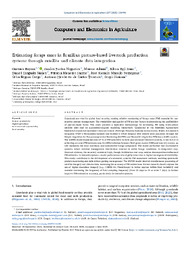Estimating forage mass in Brazilian pasture-based livestock production systems through satellite and climate data integration.
Estimating forage mass in Brazilian pasture-based livestock production systems through satellite and climate data integration.
Autoria: SILVA, G. B. S. da; NOGUEIRA, S. F.; ADAMI, M.; SANO, E. E.; NUÑEZ, D. C.; SANTOS, P. M.; PEZZOPANE, J. R. M.; GREGO, C. R.; TEIXEIRA, A. H. de C.; SKAKUN, S.
Resumo: Abstract: Grasslands are vital for global food security, making reliable monitoring of forage mass (FM) essential for sustainable pasture management. The availability and quality of FM are key factors in determining the profitability of pasture-based farms. This study presents a replicable methodology for estimating FM using multi-sensor satellite data and an agrometeorological modeling framework. Conducted at the Brazilian Agricultural Research Corporation Southeast Livestock Center (Embrapa Pecuária Sudeste) in São Carlos, Brazil, the research integrates NASA’s Harmonized Landsat and Sentinel-2 (HLS) imagery with climate data processed through the Simple Algorithm for Evapotranspiration Retrieving (SAFER) and Monteith’s Light Use Efficiency (LUE) models. The SAFER model explained over 67 % of FM variability in three pasture-based livestock systems. A key factor in achieving accurate FM estimates was the differentiation between field green matter (GM) and total dry matter, as GM represents the most nutritious and consumable forage component. The model performed best in extensive systems, where minimal management intervention resulted in stable forage conditions. In integrated crop-livestock systems, the accuracy remained high, though fertilization and crop residue decomposition influenced FM estimates. In intensive systems, model performance was slightly lower due to higher management variability. This study contributes to the development of automated, scalable FM assessment methods, enabling systematic pasture monitoring and data-driven grazing management. The SAFER model allowed simultaneous processing of satellite imagery and climate data, increasing the accuracy of FM estimations. Future research should explore the use of higher-resolution imagery (e.g., CBERS-4A, PlanetScope) to better capture within-field variability and consider increasing the frequency of field sampling frequency (from 32 days to 15 or even 7 days) to further improve FM estimation accuracy, particularly in intensive systems.
Ano de publicação: 2025
Tipo de publicação: Artigo de periódico
Unidade: Embrapa Meio Ambiente
Observações
1 - Por padrão são exibidas publicações dos últimos 20 anos. Para encontrar publicações mais antigas, configure o filtro ano de publicação, colocando o ano a partir do qual você deseja encontrar publicações. O filtro está na coluna da esquerda na busca acima.
2 - Para ler algumas publicações da Embrapa (apenas as que estão em formato ePub), é necessário ter, no celular ou computador, um desses softwares gratuitos. Sistemas Android: Google Play Livros; IOS: iBooks; Windows e Linux: software Calibre.
Acesse outras publicações
Acesse a Base de Dados da Pesquisa Agropecuária (BDPA) para consultar o acervo completo das bibliotecas da Embrapa.

